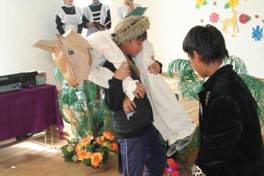Saving Saigas: Projects Around the World
Browse Our Projects
Participatory Monitoring of Saiga Populations
Participatory monitoring involves local people in monitoring natural resources in their communities. It has gained popularity in recent years as a method of collecting ecological data while engaging people in conservation and increasing their awareness of ecological issues.
Effective monitoring is key to the successful conservation of natural resources. Traditionally monitoring in countries with high biodiversity and low internal capacity has been conducted by external experts. Participatory monitoring can be more efficient than externally driven monitoring and, by increasing local people’s involvement in conservation activities, encourages responsible resource use.
A participatory monitoring programme was set up to monitor the Pre-Caspian saiga population in Kalmykia, Russia. The programme is run by a Kalmyk organization, the Centre for Wild Animals of the Republic of Kalmykia (CWA) with support from international experts through the Saiga Conservation Alliance (SCA). Monitors opportunistically record saiga sightings while working on the steppe. The programme’s two objectives are to collect robust data on the saiga population for use in management decisions and to improve attitudes towards saiga and their conservation amongst steppe inhabitants.
News: Participatory Monitoring
The experiment is completed!
Эксперимент завершен! In a number of paragraphs of the Medium-Term International Work Program for Saiga for 2016–2020, which supports the implementation of the Memorandum of Understanding regarding the conservation, restoration and sustainable use of saiga antelope...
ATTENTION TO THE PROBLEMS OF SAIGAS WAS SHOWN AT THE INTERNATIONAL CONFERENCE IN BISHKEK
Results of actual research presented at the conference are an excellent opportunity for detailed discussion, exchange of experience and attraction of attention to the objects were studied. In the beginning of August, three specialists from Russia (A.P. Mezhnev from...
Monitoring saiga populations in Kalmykia, Russia
In the summer of 2013 Leejiah Dorward, a student on Imperial College London’s Conservation Science MSc, visited Kalmykia to work with the Centre for Wild Animals to assess the success of the participatory monitoring project to date. While the data collected by the...
Winners of the USFWS-funded Small Grants programme 2011
We are pleased to announce the winners of a one-off small grants competition generously funded by the US Fish and Wildlife Service and administered by the SCA. The programme supports grassroots projects to implement the priority actions of the Medium Term Work...
Building Public Engagement for Conservation of the Ural Saiga Population Following a Mass Die-Off
Background Nearly 12,000 Critically Endangered saiga antelopes were found dead over the week commencing 19th May 2010, in the Ural population in western Kazakhstan. The dead were mostly females who had recently given birth, which suggests that their calves have also...
2nd Annual SCA Meeting held in Almaty
Between 29th-31st October, the SCA steering committee, saiga conservationists and enthusiasts met in Almaty for three meetings related to saiga conservation. First on the agenda was a meeting to evaluate the progress towards the Medium Term Work Programme of the CMS...
Participatory monitoring of saiga antelope population ecology
This project was funded by the British Council BRIDGE programme, and was joint between Imperial College London (Prof. E.J. Milner-Gulland) and Kalmykia State University (Prof. Iuri Arylov). Monitoring the population size and structure of endangered species is...
Creation of Local Saiga Management Associations
*Saiga horns are also known as ling yang (羚羊) and used in Traditional Chinese Medicine Period: January 1st 2007- December 31st 2009 Participants Fauna and Flora International Elena Bykova, Institute of Zoology, Academy of Sciences of Republic of Uzbekistan Alexander...

